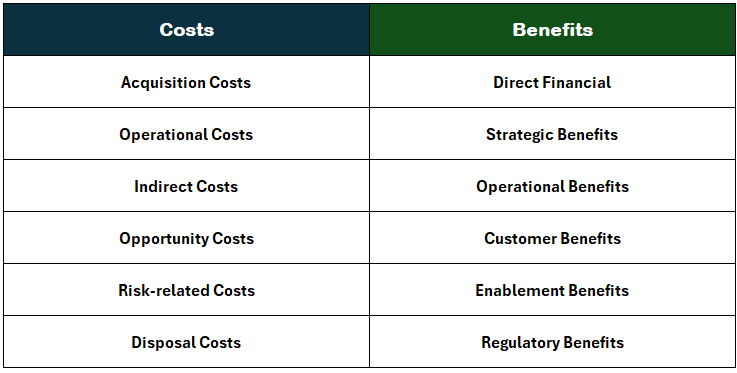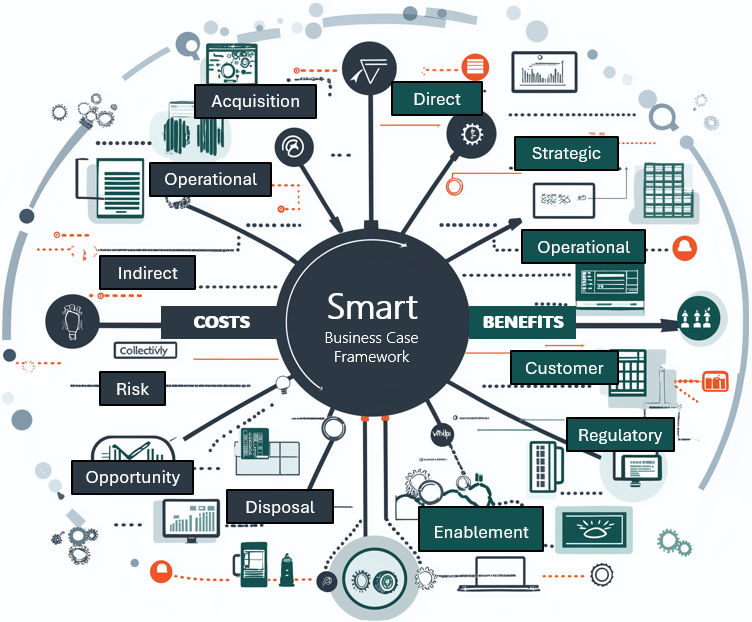The Smart Business Case Framework:
A Comprehensive Approach to Cost and Benefit Analysis
In today’s fast-paced business environment, leaders often struggle to make sound decisions on technology investments. Many business cases (BCs) tend to fall short of providing a full picture, leading to misallocated resources, underperformance, or missed opportunities. While initial costs and direct benefits are often considered, business cases frequently overlook critical second-order impacts, such as opportunity costs or the enablement benefits of a technology that could drive long-term growth.
Enter the Smart Business Case Framework, designed to systematically capture both first- and second-order costs and benefits, ensuring a thorough, data-driven approach to decision-making.
Common Pitfalls in Business Case Development
Before introducing the framework, it’s essential to understand the limitations of traditional business cases. Business leaders often encounter the following issues:
- Overemphasis on Immediate Costs and Benefits: Many BCs focus solely on the direct financial implications of an investment, neglecting the broader impact the technology could have on operations, strategy, and long-term growth.
- Failure to Capture Opportunity Costs: Opportunity costs—the value of alternatives foregone—are rarely factored into business cases, even though these costs can represent significant losses over time.
- Neglect of Second-Order Benefits: Investments in technology often enable improvements in other areas of the business, such as increased agility, scalability, or new revenue streams. These second-order benefits are frequently left out of the analysis, resulting in an incomplete picture.
- Lack of Structured Categorization: Without a clear framework, BCs can be inconsistent, leading to overlaps in cost and benefit estimations or gaps in the analysis, undermining the decision-making process.
Introducing the Smart Business Case Framework
The Smart Business Case Framework addresses these shortcomings by structuring the analysis in a way that is Mutually Exclusive, Collectively Exhaustive (MECE). This ensures that all costs and benefits are captured, without redundancy or omission, and that second-order impacts—often larger in dollar value than first-order benefits—are systematically analyzed.
Framework Overview
Cost Categories
To ensure thoroughness, costs are divided into mutually exclusive categories:
- Acquisition Costs: Includes the upfront capital expenditures such as hardware, software, licensing, and implementation.
- Operational Costs: Covers ongoing expenses, including training, maintenance, support, and personnel.
- Indirect Costs: Considers the impact on other business processes and resources, often missed in traditional analyses.
- Opportunity Costs: Evaluates the potential value lost by choosing one technology over another or delaying investment.
- Risk-related Costs: Assesses potential future risks, including cybersecurity, compliance, and technical debt.
- Disposal Costs: Covers the eventual decommissioning, transitioning to new solutions, or disposing of hardware and software.
Benefit Categories
Benefits are divided into both first- and second-order categories:
- Direct Financial Benefits: These include cost savings and efficiency gains realized through automation or reduced manual processes.
- Strategic Benefits: Highlights long-term advantages like improved market positioning, competitive differentiation, or access to new markets.
- Operational Benefits: Increased productivity, process efficiency, reduced errors, and downtime.
- Customer Benefits: Improvements in customer satisfaction, retention, or the creation of new revenue streams.
- Enablement Benefits: Technology’s ability to create future business opportunities, such as greater agility, faster time-to-market, or improved scalability.
- Regulatory and Compliance Benefits: Avoiding fines or penalties due to improved compliance through enhanced technological capabilities.
How the Framework Overcomes Common Issues
The Smart Business Case Framework offers a structured, disciplined approach that not only corrects the common shortcomings of traditional business cases but also enables leaders to make more informed, impactful decisions.
1. Capturing First- and Second-Order Impacts
Unlike traditional business cases that emphasize immediate costs and benefits, this framework explicitly accounts for second-order costs and benefits. For example, opportunity costs—the cost of not pursuing an alternative or delay—are analyzed alongside direct costs. Similarly, second-order benefits such as enhanced business agility, operational enablement, or improved customer experience are captured, ensuring that leaders don’t underestimate the long-term strategic value of a technology investment.
2. Structured, Comprehensive Analysis
The MECE principle ensures that the Smart Business Case Framework provides a comprehensive and non-overlapping analysis of all potential costs and benefits. This clarity ensures that:
- Each cost is considered separately (e.g., acquisition, operational, disposal), leaving no gaps or redundancies.
- All benefits, from immediate financial gains to longer-term strategic advantages, are systematically included. This results in a far clearer picture of the true cost-benefit profile of a technology investment.
3. Accounting for Risk and Uncertainty
The framework’s emphasis on risk-related costs provides a structured way to account for future uncertainties, such as technological obsolescence, cybersecurity vulnerabilities, or compliance challenges. By proactively considering these factors, leaders can develop strategies to mitigate potential future costs, avoiding surprises that could derail a project.
4. Facilitating Strategic Decision-Making
By capturing both first- and second-order impacts and applying the MECE approach, the Smart Business Case Framework helps business leaders develop a clearer understanding of how a technology investment will impact not just operational efficiency but also broader business outcomes. This ensures that decision-makers can:
- Evaluate how the technology fits into the company’s strategic goals.
- Quantify long-term benefits such as market differentiation or new revenue opportunities.
- Align technology investments with top-line growth and future business objectives.
Achieving Better Outcomes with the Smart Business Case Framework

Incorporating the Smart Business Case Framework into your organization’s decision-making process provides several key advantages. By thoroughly examining both direct and indirect impacts, and by ensuring that no cost or benefit is overlooked, this framework empowers leaders to:
- Make more informed decisions: A complete analysis allows for better comparison between competing technologies, ensuring that the chosen investment aligns with both short- and long-term goals.
- Avoid unexpected costs: By anticipating second-order and opportunity costs, business leaders can mitigate risks and prevent unexpected financial hits down the line.
- Maximize return on investment: The framework helps ensure that all possible benefits—especially those that drive top-line growth—are factored into the decision, ensuring the business reaps the full value of the technology investment.
The Smart Business Case Framework delivers a robust and disciplined approach, equipping organizations with the clarity and insight needed to drive success in today’s technology-driven marketplace. By moving beyond the traditional approach and systematically capturing all costs and benefits, business leaders are better positioned to make strategic, future-proof decisions.








